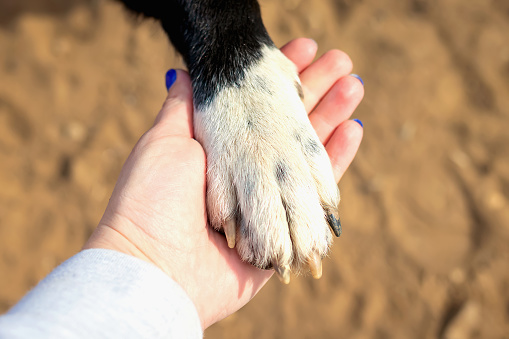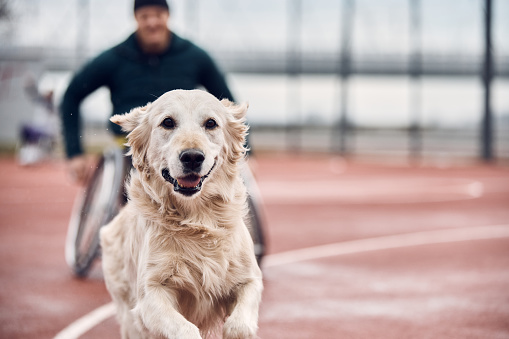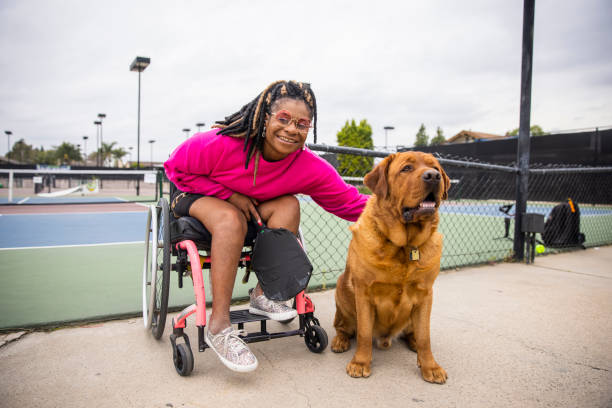2022-09-07
Training a service dog should be deemed a life-time goal, as it does not end, once the “official” training is completed. The training process can not be seen as a number of commands that the dog should be able to fulfill. It means for the dog and the handler to have a special bond with each other, to get attuned to each other and know each other as individuals, who are part of the same team.
Today we will talk about the goals we should set for ourselves and our paw friends as a team and common commands that service dogs perform.

It is much easier to achieve a goal if you divide it into smaller steps, that require specific actions. If we have to do that for service dog training, we would say that the goals should be:
1. Create trust between you and your dog;
2. Socialize your service dog;
3. Teach your service dog good manners and basic obedience;
4. Teach your service dog advanced tasks, that are specifically designed to meet your / the service dog user’s needs.
It takes time for trust to be developed between two individuals, whether two people or a person and their beloved paw friend. We always recommend positive reinforcement as an approach to train your dog. Through positive reinforcement you will actually motivate your canine to show the desired behavior. Dogs are individuals just like us, they have their own temperament and personality that need to be considered during the training process. That is why knowing your dog as an individual and encouraging him/her to behave in a proper manners are essential steps towards winning his/her trust.
Socialization begins at the moment you bring your paw friend home. Although dogs need to be vaccinated to go outside (usually not earlier than the age of 14-16 weeks), this does not mean that you have to wait until then to socialize your paw friend. You and your family members should be actively engaged in teaching the pup about its surroundings and its rights and limitations as a part of the society. Where to go potty, how to play gently, where its personal spot to eat and play is, how to behave when you are about to go outside and leave it for a few hours, how to behave around other people...these are part of the lessons your doggy will need to learn to properly integrate in his/her new living environment.
Your canine should not relieve him/herself indoor, and while outdoor he/she should not pull on the leash, show signs of aggression towards other animals or people, excessively sniff around, jump on animals or passersby, bark (unless this is required as part of a task that the dog performs) or otherwise misbehave. In general, the dog should behave as a polite and well-mannered member of society.
Gradually you can introduce basic obedience commands to your paw friend, so that he/she knows to behave him/herself at home and while in public. It is crucial for service animals to be well-mannered, otherwise they may get denied access to public places. Basic obedience commands (we will take a closer look at these a few steps down in the article) will help your dog remain in calm and settled as needed. These can be applied to various situations both at home and while in public.
The advanced training tasks, directly related to a disability, are the component that differentiates service animals from companion animals. A service dog (service animals can be dogs only or miniature horses in some states) performs tasks directly related to a person’s disability. These tasks can mitigate the symptoms of physical and/or mental disabilities and depend on the person’s needs.
Let’s take a closer look at what basic commands service dogs should know.

We will list the most common basic obedience a service dog should know. These commands are usually based on the luring method, where the owner “lures” the dog with a treat to get into a specific position. However, some owners prefer to wait for their dogs to willingly do a certain task and that way reinforce a natural behavior. This approach, known as the “capturing” method is also effective, but may require more time to bring consistent results.
1. Sit- Once you give your canine a command to sit, he/she will get into a sitting position. This command can find application in many situations both at home and while outdoor;
2. Down- This command can be perceived as an extension to the “sit” command since the approach to teach your dog to fulfill it is similar. If “sit” requires you to wave a treat above your dog’s head to lure him/her into a sitting position, the “down” command needs the treat to be moved towards the ground, so that the dog can follow it and get into a lying position;
3. Stand- The “stand” command is another command logically connected to the two listed above. Once your dog is in a sitting position, you need to start moving the treat upwards, so he/she can stand up. Then you should click, praise and reward him/her to reinforce this behavior;
4. Stay- If you need your paw friend to calmly wait for you for some time, you need to teach him/her the “stay” command. This command can be considered a long “sit” and can be especially helpful while outdoor;
5. Come- Well-behaved dogs, especially service dogs, should come to their owners when called. You need to prepare your doggy’s favorite treats and encourage him/her to come to you. You can use a sound cue (i.e. a click sound to mark the behavior) and a reward will encourage your dog to keep showing this behavior. Over time, you can implement the command “come” to the training session;
6. Name- Training your dog to recognize his/her name can be very beneficial in various situations when you want him/her to pay attention to you. This command can be very beneficial while outdoor, and you need to call your dog to come back, i.e. in the local park where your dog has moved far from you to explore the environment;
7. Look at me- Service dogs are known for their great focus skills and ability to ignore distractions while outdoor. This command is the first step towards training a dog how to remain focused on the handler. It is crucial in service dog training;
8. Leave- The “leave” command is based on prioritizing the treats, and encouraging the dog to prefer one over another. In general, you should train the dog, that he/she will get a reward of a higher value if he/she leaves the item he/she initially wanted. This approach requires you to prepare two types of treats- one of a lower value and another one of a higher value;
9. Heel- This command ensures that your dog will calmly walk at your side and be in alignment with you;
10. Walking on a loose leash- While your paw friend is still a pup and/or does not know basic obedience, you may need to keep him/her on a shorter leash that ensures a bigger control. The more advanced in basic obedience your dog is, the more freedom you should give him/her during your walks, so that he/she can enjoy the exploring the environment while being under control;
11. Back- The “Back” or “Back up” command ensures that your paw friend will not jump on people / animals, otherwise disturb passersby or prevent them from having access to certain areas/objects on the public setting;
12. Release word- Teaching your dog a release word will help him/her understand when he/she is no longer required to perform the command and can continue playing/walking/ doing what he/she was doing before that;
13. Quiet- This command will be extremely helpful if your dog is vocal, and you need him/her to remain quiet. You will need to prepare your canine’s favorite treats and reward him/her for being calm and settled;
14. Go to your spot- A very helpful command, if your dog loves greeting all your guests and visitors (overly enthusiastic). Teaching a dog his/her spot, will also help him/her get used to having his/her own designated area at home, where he/she can enjoy his/her favorite activities without being disruptive.
As we mentioned above, this list can be extended based on your preferences. However, you should follow one rule- do not move through the commands rapidly and let your dog get used with one task prior to moving to the next one. At the beginning, you should start practicing in an environment with no distractions and then add some step by step, until your dog masters the command. Monitor your dog’s response to the given commands and adjust the pace to it. He/she may need more time to perfect a command or maybe he/she needs more mental stimulation, and you should speed things up. Once your dog knows basic obedience, you can move to more advanced tasks.

There are various advanced tasks that service dogs can perform, as people have different needs based on their disability.
Common advanced service dog tasks are:
1. Guide Tasks;
2. Mobility Tasks/ Balance Tasks;
3. Retrieve Tasks;
4. Alert Tasks;
5. Allergen Detection Tasks;
6. Psychiatric Service Dog Tasks;
7. Environmental Tasks (dialing 911; turning off/on lights; cleaning objects from the floor; opening/closing doors/cupboards...etc.);
8. Interacting Tasks (notifying a specific person-usually a family member, that the owner needs help, delivering items from one person to another-usually from an employee to the handler; follow a specific person...etc.)
Since all people and dogs are different as individuals, the training process may look differently for the different teams. However, there are some things that are common for all of them-the patience, consistency, time, energy and knowledge needed to properly conduct training.